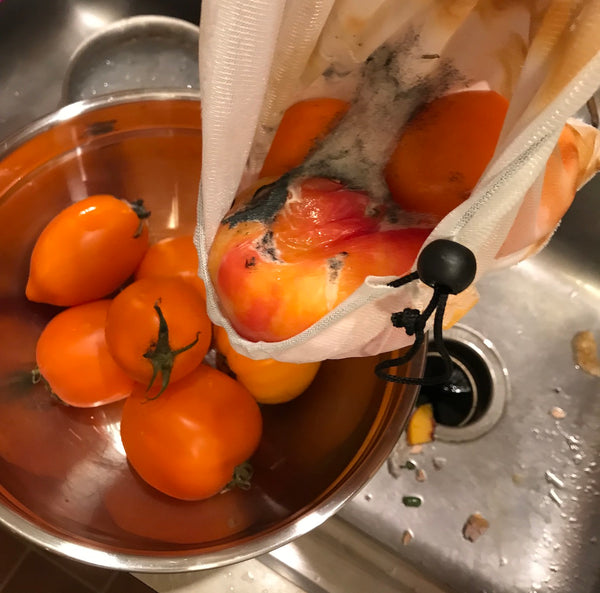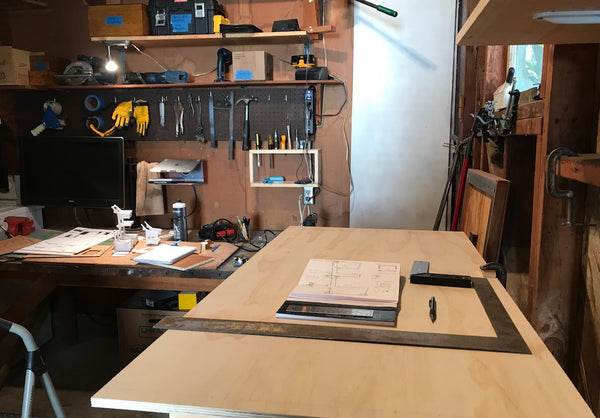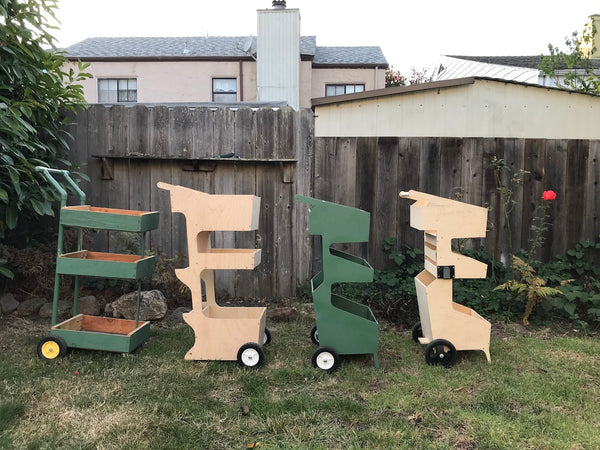So... I build carts, baskets, and other gear for shopping at farmers markets. If that seems weird, and it should, here's the story about how it all began.

Our family loves farmers markets and we have been shopping at our local market every week since 2015. First at the Mountain View, California Farmers Market and now at the Kensington Market just north of Berkeley.
I got my first real taste of farmers markets in 2003 when I attended school in San Luis Obispo, a university ag town with a famous Thursday night market. If you aren't familiar with farmers markets, here's a great article on how they operate and why they are important.
The market is very important to our family and how we shop and eat. We cook most of our meals fresh and don't freeze anything except bread and some meat. We spend nearly 40% of our food budget at the farmers market, approximately $100/week. In total we've spent around $25,000 at farmers markets in the last five years. We're proud knowing that money has gone directly to farmers and not to large grocery chains.
At first shopping at the market was easy. No kids, time to eat and meander, more money to spend. Now it's complex. Kids, less time, Covid precautions, and more careful with money. With those changes came different shopping habits that, in fact, prioritized the farmers market and not grocery stores or food delivery.
A recipe for change
Shopping this summer is what formed the catalyst for making carts. We always bring our own bags - big shopping bags and little produce bags - but during the summer months I found myself overwhelmed by carrying home so many fresh goods from our market.
The summer market trips include many fragile fruits and veggies in peak ripeness, notably strawberries, tomatoes, and peaches. Plus we started buying our eggs at the market, too. The biggest culprit was gazpacho, a chilled tomato and cucumber soup that we love. It requires lots of tomatoes, cucumbers and peppers. This bag with several squished tomatoes was a common sacrifice of loading too much into our bags.

Shopping for these items has many challenges. They are heavy, extremely fragile, and going from vendor to vendor means constantly reshuffling and reorganizing the goods. I had to plan my route along the market to buy the sturdy things first and the fragile things last. Covid brought long lines to the booths and even more chaos to the already busy shopping experience of a farmers market.
I started by bringing more bags, then a radio flyer wagon, an empty stroller, a wire 'granny cart' and more. I tried nearly every style of cart on the market. In some ways they work, but there was something wrong with all of them.
Finally I gave up and started to design my own.
A business or just an idea?
At this time the goal was not to create a new product or a business. It was simply to create something that could carry lots of items in a compact space. We just had our second child and time to shop was very limited. So in addition to carrying capacity, I also needed to move faster.
With bags, I was constantly picking them up and putting them down, squishing precious cargo while the leafy greens fell to the ground. The fully-loaded walk home was manageable, but resulted in crinkly, paralyzed hands that stopped working for a few minutes.
With the wagon and strollers I was constantly in other people's way and couldn't maneuver through the narrow stalls. The wagon was extremely loud and clumsy with a 10 foot turning radius. The stroller is smooth and nimble, but doesn't have a lot of carrying space.
With the wire carts I was struggling to use my reusable bags because there was nowhere to hang them. It's small stature meant I had to walk slowly or the bottom would catch my foot and bruise my ankle and tip over. The wire cart is the quintessential carry-all item, but its not great for carrying small, fragile, fresh things. Or for people over 6' tall.
As a consumer, I eventually had to limit the amount of items I could buy because I simply couldn't carry everything I wanted. This is a crazy thing to think about. We're trying to buy more fresh food, locally, and direct from the farmer. But we're limited by our carrying capacity.
I realize most people don't hit that limit, but we did. I later spoke with lots of shoppers who encountered this exact problem and they shared their work-arounds. Multiple trips to the car, shop at multiple markets, supplement with CSA boxes. All valid, but didn't help me at my market in the time I had to shop.
Solving a personal problem
Consistently unsatisfied with the current options, I wanted to create my own solution.

I have tools since I'm always building or planning to build something and there was a little space in the garage to get started with cardboard, foam board, and later wood. When the kids were asleep I would work a couple of hours here and there.
For a few months I would draw new designs, build them, and take them to the market. Every few weeks I had a different version or at least some major change to the existing one. I spent a lot of time and money at my local Ace Hardware and lumber supply stores.
It was fun to be creative and regularly put these carts to use. The feedback loop for each prototype was quick and I was learning as I went. Shoppers and vendors at the market were interested to know more and this consistent source of conversation about the latest cart was a big boost in my creativity and productivity.

"Keep Prototyping!"
While getting deep into this process in October 2020 I reached out to a friend who works in product design. We've known each other a long time and he was eager to help and steer me in the right direction.
We had some phone calls and he put me in touch with another designer who has worked at stroller company before. This experience was very important because strollers have many innovative features designed for a pleasant experience. This differs greatly from shopping carts which are more utilitarian and shoppers don't own them or transport them home.
Once my solid, no-frills prototype was nearly complete, the stroller design research was quite fun. Per the designer's advice, "keep prortotyping!" he would say and I would keep going. I spent a lot of time inspecting our own strollers, researching online, and I went to BuyBuyBaby for inspiration seeking the latest and greatest in brakes, handles, folding, click-in-click-out latches, wheels, and more. When I found one I really liked ($350!) I bought a used one on Craigslist ($45!) to take apart and 'Frankenstein' to my own cart.

Disassembling a stroller for its parts is not easy and I burned through several drill bits and saw blades doing it. But in the end I had something pretty amazing. So cool in fact, that the stroller features were going to be the hardest ones to replicate on my professional prototype.
Showing off my Frankenstein
With my super awesome cart in tow, I was really flying high at the market. Farmers market shoppers are generally very friendly and chatty. With Covid safety measures and the election shit-show, all that changed. Social distancing and masks meant there was less banter and time hanging around. But that didn't stop people from striking up conversations regularly about the cart. They were very eager to comment "Great cart!" or ask "Did you make that?"
As the cart got better, the conversations got more interesting.
"How did you make that?"
"Have you shown Chris the market manager?"
"You should sell those!"
When the stoller-ified version was cruising around, it made everyone smile. When I demoed the latch for people, they were even more impressed.

"You just made my day!"
My favorite was "That cart is on point!"
Hire a Professional
Eventually Frankenstein was pretty near complete, my skills were plateauing, and I broke all my jigsaw blades. I knew the process of converting this handmade version to CAD and actually making one would be another big project. Again I went back to my product designer and we talked through some options. I wanted it to be made locally and out of wood, which is a ridiculous idea. Things like this just aren't made here, or out of wood! More on that topic another time.
Fortunately he knew a former colleague with the tools and a small team interested to learn more about the project. Those early calls and emails went well and we signed NDA's and other paper work right before Thanksgiving 2020. This was a huge milestone because the other manufactures I spoke with were not eager to help me build the first one. They could make 100 or 1000, but I wasn't ready for that yet.
Those three months from September to November are now a blur. New born baby, building a prototype, Covid spikes, the election drama. It was a lot to cram in such a short, chaotic and emotional time. After that contract was signed I was very hopeful and still had a lot to learn about working with engineers and building something great.
I continue the story in the next post Building Prototype One.
Leave a comment